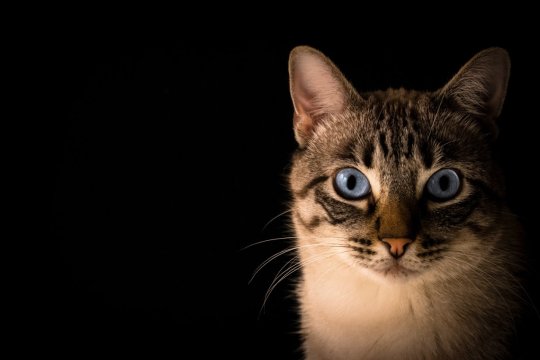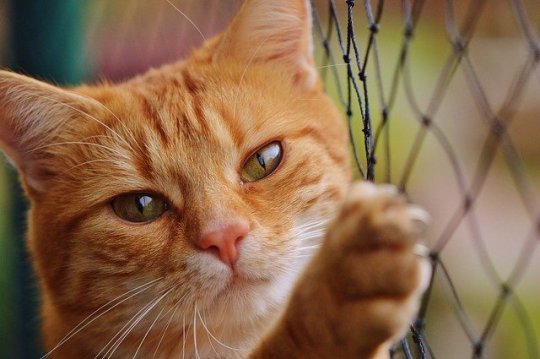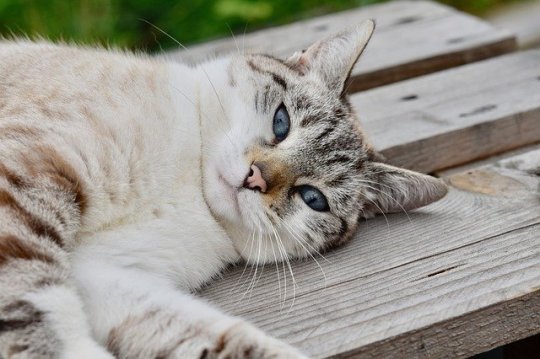#enrofloxacin for dogs side effects
Text
Urinary Tract Infections in Cats

Bacterial urinary tract infections can result from normal GI tract and skin flora that ascends the urinary tract and overcomes its natural defenses that typically prevent colonization. While bacterial UTIs are among the most common diseases that affect dogs, they are less common in young cats. However, they affect many older cats as they become more susceptible to infection due to aging or concomitant disease (diabetes, hyperthyroidism, or renal failure).
In this article, we’ll look at the signs and symptoms of UTIs in cats, whether they can be prevented, how they can be treated, and other useful information for cat parents.
Causes
Many retrospective studies have found that one of the most common bacterial uropathogens in both dogs and cats is Escherichia coli. Escherichia coli is an epiphyte, which means that it naturally grows in different organs, and it can even be found on the skin of our pets. It is found in both feces and urine, and whenever the cat’s immune system isn’t on par, the urinary tract might be affected by an Escherichia coli infection.
Some of the other common pathogens that are likely to cause UTIs are Staphylococcus, Streptococcus, Proteus, Pseudomonas, and Klebsiella species.
Ideally, an infection can be treated correctly only if the pet owner collects some urine and brings it to the vet (as soon as possible) for it to be analyzed in the lab. This means that the pathogen will be detected or that at least an antibiogram will be performed. With the right antimicrobial therapy, the cat can both recover faster, and recurrences can be prevented effectively.

Clinical signs
Most cats are going to try to groom their genital area excessively, and this can be the first sign that a pet parent might notice. Some of the others include the following:
Frequent attempts to urinate
Urinating in unusual places (even next to the litter box)
Vomiting
Lethargy
Discolored urine
Pain (many cats will cry out when they use the litter box)
Abnormal-smelling urine
Cats that aren’t changed their cat litter frequently are more predisposed to getting a UTI simply because they come in direct contact with their urine and feces.
Detection
The most significant challenge that vets face when a cat experiencing urinary problems is brought in is trying to make the difference between a UTI, a Feline Urethral Obstruction, and a case of general FLUTD. Most cases will call for a urine sample, a urine culture, as well as a physical examination.
In most situations where the cat suffers from a urinary tract infection, there is a painful and rather small bladder present. By contrast, in cases of obstruction, the bladder is distended and large.
A urine sample can reveal several important details. One of them is the urine concentration, but other things such as the presence of red blood cells, white blood cells, as well as crystals, can be seen under the microscope, as well. Sometimes, the vet can even see actual bacteria under the microscope. A urine culture is by far the most helpful test when it comes to setting a correct diagnosis.
Treatment
If a urine culture was performed, it could be quite easy for the vet to do antimicrobial susceptibility testing. Some of the most common antibiotics used in the treatment of UTIs are amoxicillin, ampicillin, cephalexin, chloramphenicol, enrofloxacin, gentamicin, tetracyclines, as well as trimethoprim-sulfonamides.
The selected antimicrobial should also be easy for pet parents to administer and have as few side effects as possible. Depending on how complicated the infection is, the duration of the treatment can last anything from 7 to 14 days. Chronic and complicated cases of UTI and prostatitis could require antimicrobial treatment for as many as 4 to 6 weeks.
It is paramount for the pet parent to understand that they shouldn’t stop the administration of the treatment for fear of the germ developing antibiotic resistance. It’s also recommended that after the first week of treatment, a urine sample is collected again to see whether the UTI has resolved or not.
Generally, most cats that have had a urinary tract infection are likely to have another in the future. If possible, monitor your cat’s urinary tract health as best as possible.

Prevention
Taking several steps to prevent UTIs in your cat is crucial. You can start by constantly keeping the litter box clean so that bacteria have almost no chance of spreading in the environment. The cat’s diet can be a contributing factor, as well. If your cat is slightly overweight or a diabetic, he or she might be at a greater risk of getting urinary tract disease.
The urinary tract health of some cats can be affected by stress, as well. If you know that you’re going to be adding a new feline member to your family anytime soon, it would be a good idea to try to make the transition as smooth as possible.
Make sure you provide plenty of clean water to your feline buddy every day. It’s widely known that cats don’t drink a lot of water, and if it’s not clean or fresh, they are probably not going to drink any. Evaluate your cat’s diet and get some recommendations from the vet, especially if you have a diabetic or an overweight pet.
If you have more than one feline companion, it is highly recommended that you use several litter boxes, not just one. In the end, prevention is the best cure, so pay attention to any changes in your cat’s daily routine and urinary habits. Sometimes, catching a urinary tract problem in its early stage can prevent it from becoming complicated and it can also alleviate some of the pain.
Cristina Vulpe is a former veterinarian turned content marketer. She manages a website about cats, My Feline Buddy, where she gives advice about cat health, managing cat behavior, and many other cat-related things. She has a PhD in veterinary oncology and is passionate about animal welfare, nutrition, parasitology, as well as infectious diseases.
Read the full article
1 note
·
View note
Text
Enrofloxacin Market Insight :-
The global enrofloxacin market size is expected to witness potential gains in the future, and register a significant CAGR over the forecast period (2019 - 2027).
Market Overview
Enrofloxacin (ENR) is a fluoroquinolone antibiotic and a veterinary antibacterial agent. It is sold under the trade name Baytril by the Bayer Corporation. ENR is currently approved for treatment of individual pets and domestic animals in the U.S. by the U.S. Food and Drug Administration (FDA). ENR is effective against a several gram-positive and gram-negative bacteria such as Pseudomonas aeruginosa, Klebsiella, and E.coli. It is used for the treatment of infections of skin and soft tissue, urinary tract infections in dogs and cats, Chlamydophila felis infections in cats, and ulcerative colitis caused by Escherichia coli in dogs. Significant growth in the poultry sector is expected to have positive impact on the market growth of enrofloxacin over the forecast period.
Market Dynamics
Increasing use of ENR in treatment of infections caused by both Gram-negative and Gram-positive bacteria is expected to boost the market growth. ENR is administered to cattle by subcutaneous injection and to pigs by intramuscular injection. It is administered orally to cattle, pigs, turkey, and chickens, for the treatment of infections of the respiratory and alimentary tract.
However, in rare instances, use of ENR in cats has been linked with retinal toxicity. The drug cannot be used in pets that are allergic to it. ENR is also associated with some side effects such as vomiting, diarrhea, and lack of appetite. Moreover, effective in September 2005, enrofloxacin was withdrawn from use in the U.S. poultry farms. These factors are expected to hinder growth of the enrofloxacin market over the forecast period.
Increasing trend of adopting pets is expected to offer lucrative opportunities for market players to enhance their market share.
Market Outlook
Asia Pacific is expected to hold dominant position in the enrofloxacin market over the forecast period. Factors such as growing population and high demand for poultry meat are expected to impact the market growth. Moreover, significant growth in the pet industry in China is also expected to contribute to the market growth in Asia Pacific. Restrictions on the use of ENR in the U.S. is expected to adversely affect growth of the market in North America.
Request the sample copy of here:
https://www.coherentmarketinsights.com/insight/request-sample/2742
Download the PDF Brochure here:
https://www.coherentmarketinsights.com/insight/request-pdf/2742
Key Players
Some of the major players operating in the global enrofloxacin market include, Bayer Corporation, KRKA d.d., Novo mesto, Pro Zoon, Chanelle Pharmaceuticals, VetMedic, and VM Pharma.
Buy now the market research report here:
https://www.coherentmarketinsights.com/insight/buy-now/2742
About Us:
Coherent Market Insights is a global market intelligence and consulting organization focused on assisting our plethora of clients achieve transformational growth by helping them make critical business decisions.
What we provide:
Customized Market Research Services
Industry Analysis Services
Business Consulting Services
Market Intelligence Services
Long term Engagement Model
Country Specific Analysis
Explore CMI Services here
Contact Us:
Mr. Shah
Coherent Market Insights Pvt. Ltd.
Address: 1001 4th Ave, #3200 Seattle, WA 98154, U.S.
Phone: +1-206-701-6702
Email: [email protected]
Source:
https://www.coherentmarketinsights.com/ongoing-insight/enrofloxacin-market-2742
0 notes
Text
Enrofloxacin Market : Get Facts About Business Strategies 2019–2027

The global enrofloxacin market size is expected to witness potential gains in the future, and register a significant CAGR over the forecast period (2019 – 2027).
Try Free Sample Report @ https://www.coherentmarketinsights.com/insight/request-sample/2742
Market Overview
Enrofloxacin (ENR) is a fluoroquinolone antibiotic and a veterinary antibacterial agent. It is sold under the trade name Baytril by the Bayer Corporation. ENR is currently approved for treatment of individual pets and domestic animals in the U.S. by the U.S. Food and Drug Administration (FDA). ENR is effective against a several gram-positive and gram-negative bacteria such as Pseudomonas aeruginosa, Klebsiella, and E.coli. It is used for the treatment of infections of skin and soft tissue, urinary tract infections in dogs and cats, Chlamydophila felis infections in cats, and ulcerative colitis caused by Escherichia coli in dogs. Significant growth in the poultry sector is expected to have positive impact on the market growth of enrofloxacin over the forecast period.
Market Dynamics
Increasing use of ENR in treatment of infections caused by both Gram-negative and Gram-positive bacteria is expected to boost the market growth. ENR is administered to cattle by subcutaneous injection and to pigs by intramuscular injection. It is administered orally to cattle, pigs, turkey, and chickens, for the treatment of infections of the respiratory and alimentary tract.
However, in rare instances, use of ENR in cats has been linked with retinal toxicity. The drug cannot be used in pets that are allergic to it. ENR is also associated with some side effects such as vomiting, diarrhea, and lack of appetite. Moreover, effective in September 2005, enrofloxacin was withdrawn from use in the U.S. poultry farms. These factors are expected to hinder growth of the enrofloxacin market over the forecast period.
Increasing trend of adopting pets is expected to offer lucrative opportunities for market players to enhance their market share.
Market Outlook
Asia Pacific is expected to hold dominant position in the enrofloxacin market over the forecast period. Factors such as growing population and high demand for poultry meat are expected to impact the market growth. Moreover, significant growth in the pet industry in China is also expected to contribute to the market growth in Asia Pacific. Restrictions on the use of ENR in the U.S. is expected to adversely affect growth of the market in North America.
Request For Customization of Research Report @ https://www.coherentmarketinsights.com/insight/request-customization/2742
Key Players
Some of the major players operating in the global enrofloxacin market include, Bayer Corporation, KRKA d.d., Novo mesto, Pro Zoon, Chanelle Pharmaceuticals, VetMedic, and VM Pharma.
0 notes
Link
Infections are common issues in pets. In most cases, the vets prescribe enrofloxacin for animals. The vet prescribes this medication to control bacteria or infections such as bone infections, ear infections, sinus, and pneumonia.
#enrofloxacin for animals#enrofloxacin for cats#enrofloxacin for dogs#enrofloxacin for dogs dosage#enrofloxacin for dogs side effects#enrofloxacin injection veterinary use#Thailand
0 notes